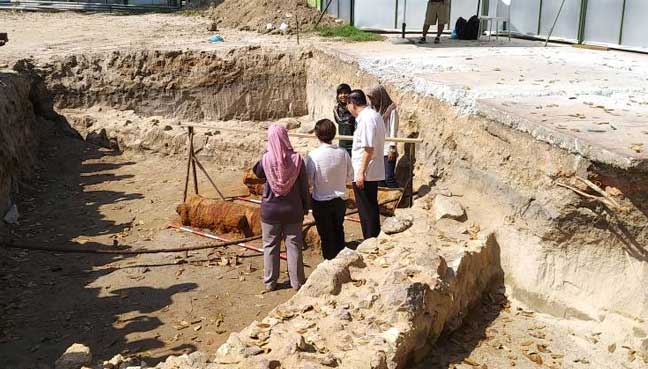(From left) USM archaeologists Noridayu Bakry, Saw Chaw Yeah, Nurulnatasha Azman and Suhana Yusof showing the cannonballs found at the old fort.
GEORGE TOWN: An archaeological team digging up a covered-up moat at Fort Cornwallis discovered nine cannonballs last week.
They were found not far from where two 200-year-old cannons were found two weeks ago.
Universiti Sains Malaysia’s (USM) Centre for Global Archaeological Research archaeologist Nurulnatasha Azman said the projectiles, 3cm to 10cm in diameter, were likely as old as the cannons.
She said the cannonballs appeared to be very fragile and they would be transferred by this week to USM for safekeeping, together with the two cannons weighing 1.5 tonnes each found earlier.
“The latest discovery is not associated with the cannons found two weeks ago, but it is likely from a different cannon,” Nurulnatasha told reporters at the site today. Also present was Penang Chief Minister Lim Guan Eng.
The findings are significant because the fort was never involved in any combat.
Besides Nurulnatasha, two other archaeologists, Noridayu Bakry, and Suhana Yusof, were in the team that found the cannonballs between Feb 26 and Feb 28.
The centre’s director, Mokhtar Saidin, said his team of researchers were looking for the main entrance to the fort, as part of a re-examination of the 232-year-old fort.

Excavation proceeding in the moat surrounding Fort Cornwallis.
The centre was digging a covered-up moat, which is 9m wide and 2m deep, surrounding the fort. It was filled up in the early 1920s after a malaria epidemic that hit the island.
The cannons, 2.35 metres and 2.2 metres in length, were unearthed on the western side of the fort, 1.2 metres below ground.
Researchers believe the cannons were likely made out of copper, with the innards made from iron.
The inscriptions on them suggested that they date back to the reign of King George III of the United Kingdom, who ruled Britain and Ireland from 1760 to 1820.
The dig is commissioned by the George Town Conservation and Development Corporation. This is a collaboration of the Penang government, Think City and the Aga Khan Trust for Culture.
Fort Cornwallis, the largest standing fort in Malaysia, is named after then governor-general of Bengal, Charles Cornwallis, one of the leading British generals famed for his involvement in the American War of Independence.
It was built in 1786 by the East India Company, using nibong (palm trunks), to protect Penang from pirates and threats from Kedah.
Penang was originally under the Kedah sultanate until East India Company’s Captain Francis Light took over the island.
In 1810, it was rebuilt using bricks and mortar. A lighthouse stands at the northeast corner of the fort, built in 1882. It currently does not serve any navigational purpose.
It was also used as storage for gunpowder, a chapel and cell rooms to hold prisoners. Currently, the site is open to visitors for a fee of RM10, from 9am to 10pm. -FMT


No comments:
Post a Comment
Note: Only a member of this blog may post a comment.